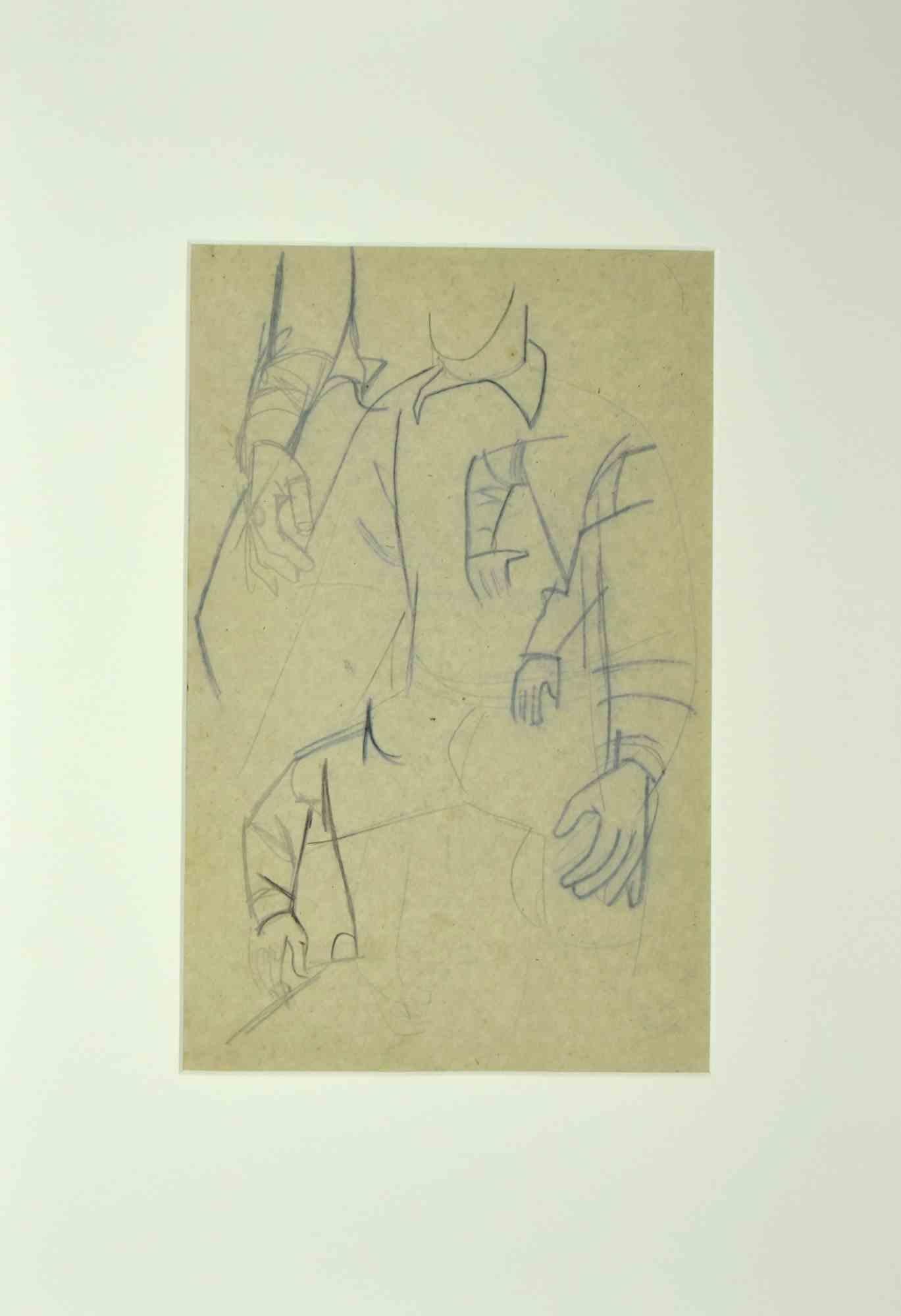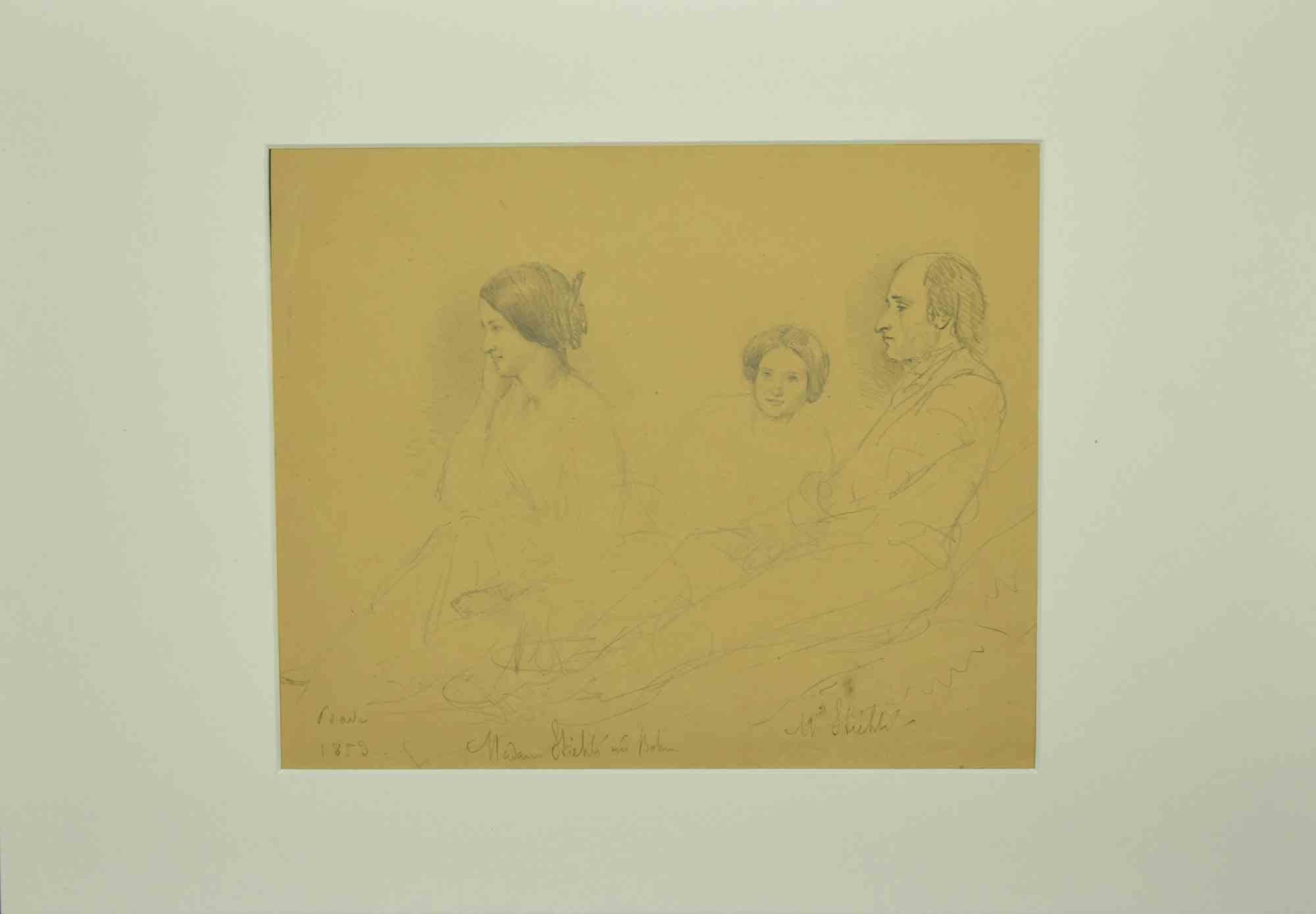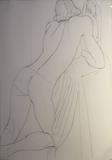Items Similar to Double Nude - Original Drawing - Early 20th Century
Want more images or videos?
Request additional images or videos from the seller
1 of 2
UnknownDouble Nude - Original Drawing - Early 20th CenturyEarly 20th Century
Early 20th Century
About the Item
Double Nude is an original artwork realized by an Anonymous French artist in the first years of the Twentieth Century. Pencil on paper. Cardboard passepartout inlcuded (cm 49 x 34). Very good conditions.
Simple and elegant artwork representing a double portrait with two nudes. The figure are stylized and sketched and are realized with a fresh and rapid stroke.
- Creation Year:Early 20th Century
- Dimensions:Height: 12.21 in (31 cm)Width: 7.88 in (20 cm)Depth: 0.04 in (1 mm)
- Medium:
- Movement & Style:
- Period:
- Condition:Insurance may be requested by customers as additional service, contact us for more information.
- Gallery Location:Roma, IT
- Reference Number:
About the Seller
4.9
Platinum Seller
These expertly vetted sellers are 1stDibs' most experienced sellers and are rated highest by our customers.
1stDibs seller since 2017
6,757 sales on 1stDibs
Typical response time: 2 hours
- ShippingRetrieving quote...Ships From: Monaco, Monaco
- Return PolicyA return for this item may be initiated within 14 days of delivery.
More From This SellerView All
- Musicians - Pencil on paper - 20th centuryLocated in Roma, ITMusicians is an original drawing in pencil on paper, realized by an Anonymous artist of The early XX century. The State of preservation is good. The artwork represents a joyful sce...Category
20th Century Modern Figurative Drawings and Watercolors
MaterialsPaper, Pencil
- Couple - Original Drawing in Pencil - 20th CenturyLocated in Roma, ITCouple is an original drawing in pencil realized by an unknown artist of the XX century. Sheet dimension: 39 x 38 cm Very good conditions except with small tearing on the margins. ...Category
20th Century Modern Figurative Drawings and Watercolors
MaterialsPencil, Paper
- Crucified Christ - Pencil and Watercolor attire. to Jacques Villon - 1950sBy Jacques VillonLocated in Roma, ITCrucified Christ is an original artwork in watercolor and pencil attributed to Jacques Villon. Not signed, good conditions. The artwork represents C...Category
1950s Modern Figurative Drawings and Watercolors
MaterialsPaper, Watercolor, Pencil
- Figure - Drawing by Henri Lucien Detouche - 19th CenturyLocated in Roma, ITFigure is an original sanguine drawing on ivory paper, realized by Henri Lucien Detouche (1854-1913). The state of preservation of the artwork is good. Unsigned, annotated "Henriet...Category
19th Century Modern Figurative Drawings and Watercolors
MaterialsColor Pencil, Paper
- Hurki Costume for an opera - Pencil and watercolor drawing by Taho - 1930sLocated in Roma, ITCostume for an opera is an original artwork realized by Taho in the 1930s. Beautiful pencil and watercolor drawing on cardboard. Good conditions.Category
1930s Modern Figurative Drawings and Watercolors
MaterialsPaper, Watercolor, Pencil
- Figures - Drawing by Mino Maccari - Mid 20th CenturyBy Mino MaccariLocated in Roma, ITFigure is an original Pencil Drawing and Watercolour realized by Mino Maccari in mid-20th century. Good condition on a yellowed paper. Hand-signed by the artist with pencil. Mino ...Category
Mid-20th Century Modern Figurative Drawings and Watercolors
MaterialsPaper, Watercolor, Pencil
You May Also Like
- Cynthia BackBy Fritz BultmanLocated in New Orleans, LAFritz Bultman set himself apart from other Abstract Expressionists with his meticulously organized abstract compositions, use of sculpture, and the adoption of collage as a core prac...Category
1980s Modern Figurative Drawings and Watercolors
MaterialsPaper, Graphite
- MarianneBy Fritz BultmanLocated in New Orleans, LAFritz Bultman set himself apart from other Abstract Expressionists with his meticulously organized abstract compositions, use of sculpture, and the adoption of collage as a core prac...Category
1980s Modern Figurative Drawings and Watercolors
MaterialsPaper, Graphite
- Dancer in a Landscape - 20th Century, Work on paper by John CraxtonBy John CraxtonLocated in London, GBPencil, charcoal and conté crayon and gouache on paper Provenance: Christopher Hull Gallery Private collection, UK 1992Category
1940s Modern Figurative Drawings and Watercolors
MaterialsPaper, Charcoal, Crayon, Gouache, Pencil
- 'Oleta's Hat', Carmel Art Association Exhibit, California Woman Artist, SFMALocated in Santa Cruz, CASigned lower right, 'V. Conroy' for Virginia Conroy (American, 1922-2006) and dated 1985. Exhibited: Carmel Art Association, 1983 (on original backing...Category
1980s Modern Portrait Drawings and Watercolors
MaterialsGraphite, Paper, Watercolor, Gouache
- Boston Abstract Expressionist Hyman Bloom Original Pencil Drawing Martin SumersBy Hyman BloomLocated in Surfside, FLThis is a unique artwork. This is an original Hyman Bloom drawing of fellow artist and his very good friend Martin Sumers.I believe this was drawn at the “variations of a theme” at Sumers gallery in NYC. The last two photos show a poster and a card from their shows. it is not included in this listing, it is just for provenance. Provenance: Acquired from the Sumers estate collection. Hyman Bloom (March 29, 1913 – August 26, 2009) was a Latvian-born American painter. His work was influenced by his Jewish heritage and Eastern religions as well as by artists including Altdorfer, Grünewald, Caravaggio, Rembrandt, Blake, Bresdin, James Ensor and Chaim Soutine. He first came to prominence when his work was included in the 1942 Museum of Modern Art exhibition "Americans 1942 -- 18 Artists from 9 States". MoMA purchased 2 paintings from the exhibition and Time magazine singled him out as a "striking discovery" in their exhibition review. His work was selected for both the 1948 and 1950 Venice Biennale exhibitions and his 1954 retrospective traveled from Boston's Institute of Contemporary Art to the Albright Gallery and the de Young Museum before closing out at The Whitney Museum of American Art in 1955. In a 1954 interview with Yale art professor Bernard Chaet, Willem de Kooning indicated that he and Jackson Pollock both considered Bloom to be “America’s first abstract expressionist”, a label that Bloom would disavow. Starting in the mid 1950s his work began to shift more towards works on paper and he exclusively focused on drawing throughout the 1960s, returning to painting in 1971. He continued both drawing and painting until his death in 2009 at the age of 9 Hyman Bloom (né Melamed) was born into an orthodox Jewish family in the tiny Jewish village of Brunavišķi in what is now Latvia, then part of the Russian Empire At a young age Bloom planned to become a rabbi, but his family could not find a suitable teacher. In the eighth grade he received a scholarship to a program for gifted high school students at the Museum of Fine Arts. He attended the Boston High School of Commerce, which was near the museum. He also took art classes at the West End Community Center, a settlement house. The classes were taught by Harold Zimmerman, a student at the School of the Museum of Fine Arts, who also taught the young Jack Levine at another settlement house in Roxbury. When Bloom was fifteen, he and Levine began studying with a well-known Harvard art professor, Denman Ross, who rented a studio for the purpose and paid the boys a weekly stipend to enable them to continue their studies rather than take jobs to support their families. He took Bloom and Levine on a field trip to the Museum of Modern Art in New York, where Bloom was impressed by the work of Rouault and Soutine and began experimenting with their expressive painting styles. In the 1930s Bloom worked sporadically for the Public Works of Art Project and the Federal Art Project (WPA), He shared a studio in the South End with Levine and another artist, Betty Chase. It was during this period that he developed a lifelong interest in Eastern philosophy and music, and in Theosophy. He first received national attention in 1942 when thirteen of his paintings were included in the Museum of Modern Art (MoMA) exhibition Americans 1942: 18 Artists from 9 States, curated by Dorothy Miller. MoMA purchased two of his paintings from that exhibition, and he was featured in Time magazine. The titles of his paintings in the exhibition reflect some of his recurring themes. Two were titled The Synagogue, another, Jew with the Torah; Bloom was actually criticized by one reviewer for including "stereotypical" Jewish images. He also had two paintings titled The Christmas Tree, and another titled The Chandelier, both subjects he returned to repeatedly. Another, Skeleton (c. 1936), was followed by a series of cadaver paintings in the forties, and The Fish (c. 1936) was one of many paintings and drawings of fish he created over the course of his career. Bloom was associated at first with the growing Abstract Expressionist movement. Willem de Kooning and Jackson Pollock, who first saw Bloom's work at the MoMA exhibition, considered Bloom "the first Abstract Expressionist artist in America." In 1950 he was chosen, along with the likes of de Kooning, Pollock, and Arshile Gorky, to represent the United States at the Venice Biennale. That same year Elaine de Kooning wrote about Bloom in ARTnews, noting that in paintings such as The Harpies, his work approached total abstraction: "the whole impact is carried in the boiling action of the pigment". In 1951 Thomas B. Hess reproduced Bloom's Archaeological Treasure in his first book, Abstract Painting: Background and American Phase, along with works by Picasso, Pollock, and others. Both de Kooning and Hess remarked on Bloom's expressive paint handling, a key characteristic of Abstract Expressionist painting. As abstract expressionism dominated the American art world, Bloom became disenchanted with it, calling it "emotional catharsis, with no intellectual basis." In addition, instead of moving to New York to pursue his career, he opted to stay in Boston. As a result he fell out of favor with critics and never achieved the kind of fame that Pollock and others did. He disliked self-promotion and never placed much value on critical acclaim. Many of Bloom's paintings feature rabbis, usually holding the Torah. According to Bloom, his intentions were more artistic than religious. He began questioning his Jewish faith early in life, and painted rabbis, he claimed, because that was what he knew. Over the course of his career he produced dozens of paintings of rabbis...Category
20th Century Modern Figurative Drawings and Watercolors
MaterialsPaper, Pencil
- The Gathering, Train Station Pastel, British Mid 20th CenturyBy Peter GardnerLocated in London, GBPastel and graphite on paper Image size: 8 1/4 x 5 inches (21 x 12.75 cm) Contemporary style handmade frame The Artist Peter Gardner was born in London in 1921. He studied at the ...Category
Mid-20th Century Modern Figurative Drawings and Watercolors
MaterialsPaper, Pastel, Graphite
Recently Viewed
View AllMore Ways To Browse
Double Portrait
Twentieth Century Drawings
Early Twentieth Century Paintings
Nude Figure Sketch
Early 20th Century Pencil Sketch
Pencil Sketch Figure
Figural Pencil Sketch
Istvan Farkas
Henry Wormser
Mednyanszky Laszlo
Jorgen Nash
Moll Flanders
Mai Thu
Peregrine Honig On Sale
Ruby Bateman
Serge Fotinsky
Vintage Bil
Vintage Bathtub Illustration





